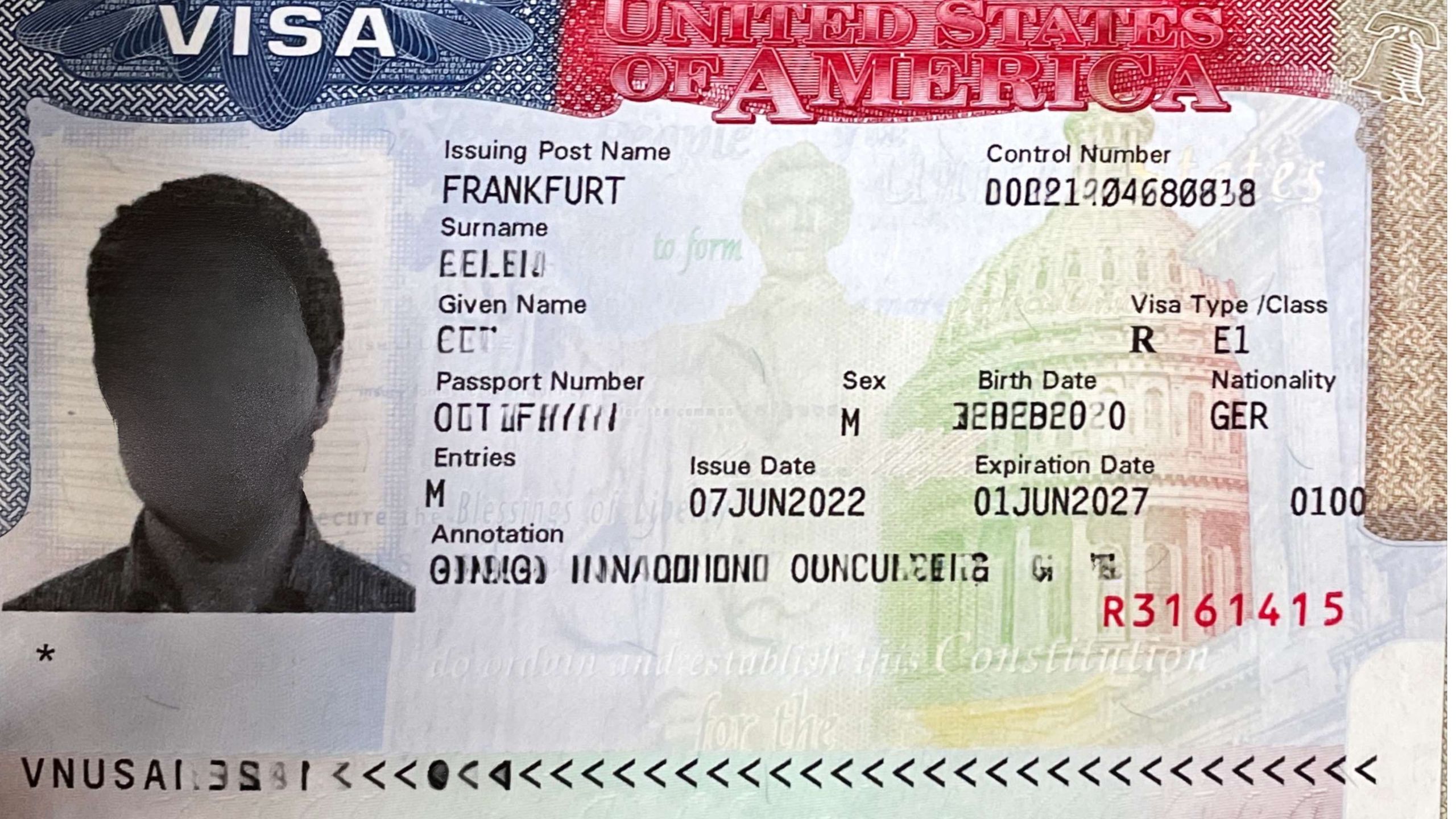The E visa belongs to the category of work visas and allows holders to stay temporarily to take up employment in the USA. We will be happy to check whether your company and your employees qualify for the E category.

The E visa is divided into two subcategories. Depending on the company's entry requirements, applicants can apply for a E-1 visa or E-2 visa. Further information, such as the respective validity periods, application processes or special features of the two E visa categories, can be found on the respective subpages.
Name: Treaty Trader visa
For whom: (commercial) traders
Validity: Maximum 5 years
Name: Treaty Investor visa
For whom: investors
Validity: Maximum 5 years
Once the first employee of a company has received an e-visa, the company is considered to be "E registered". This simplifies the application process for additional visas and allows the company to send qualified employees faster and easier to the USA.
Unlike many other work visa categories, there is no minimum employment period requirement for an E visa, i.e., in principle, even newly hired employees will be sent to the USA with this visa. In practice, however, it is increasingly difficult to prove that specialized knowledge exists despite a short period of employment.
Since the e-visa is relatively cost-effective and the application procedure less time consuming. However, it is always an alternative worth considering to other US work visas, such as the L visa.
E visas contain a great deal of information that serves to identify the holder and defines the rights and restrictions during the stay in the United States.
It is important to check this information carefully and ensure that it meets the requirements of your planned stay in the USA.

The following data and information can be found on a US visa:
The e-visa is based on bilateral agreements between the United States and 50 or 80 other countries. Therefore, only companies from these treaty countries can apply for the visa. A list of these countries can be found on the website of the U.S. Department of State.
The E-1 visa and the E-2 visa are both non-immigrant visas for investors and traders who want to do business in the USA. But how exactly do the two US visas differ from each other? Here is a comparison of the two visas:
Purpose and scope of application
Authorized applicants
Investment requirements
Duration and extension options
Work authorization
Purpose and scope of application
Authorized applicants
Investment requirements
Duration and extension options
Work authorization

The period of validity of an e-visa depends on the nationality. Depending on the nationality, the so-called reciprocity schedule how long the visa will be valid for. For example, German nationals normally receive a five-year E-1 or E-2 visa.
However, consular officials also have the option of limiting the duration of the visa. This is the case, for example, if the company is quite small or has relatively low investment capital. In addition, the granting of visas for smaller companies can be based on the remaining registration period. However, for medium-sized to large companies with a high number of US employees, e-visas are usually issued for five years, regardless of how long the e-registration is still valid.
On average, holders of an E-1 or E-2 visa can stay in the USA for around 2 years at a time. However, upon entry into the United States, border officials decide how long E visa holders may stay in the United States, which may well be a different date than the one stated on the visa.
The permitted length of stay for e-visa holders is noted digitally on the I-94 form. Travelers to the USA rarely receive an entry stamp in their passport, so we recommend checking the I-94 status online immediately after entering the country.
We advise you on the choice of the appropriate visa category and take over the complete processing for you or your company.

The visa fees for E visa are at 299.25 € (315 $) per applicant. The general application fee of the US consulates or US embassies must be paid by all applicants and cannot be refunded or transferred to other persons.

In addition, for some E visa applicants incur additional costs:
Further information about the different visa fees, other possible costs and the current payment methods can be found on our fees page.
It is important to note that applying for an E visa requires a thorough understanding of the process and careful planning of the steps required. There are numerous important aspects to consider, from choosing the appropriate visa type according to the purpose of the trip through to the correct completion of the application forms and preparation for the visa interview.
The following section explains the individual steps for applying online for an E-1 or E-2 visa for the USA and provides a guide to a successful visa application.
E-visa applicants between the ages of 14 and 79 usually have to go through the consular procedure. This means that, in most cases, the E visa is issued as part of a personal interview in a responsible US representation (US consulate or US embassy) in the home country.
A US work visa is always tied to a specific US company. In turn this means that you must have a specific employer in the United States before you can apply for a work visa.
The application process begins with the US company that wants to hire you. The US employer submits the petition either to the USCIS or to the responsible U.S. consulate. Since the application for a temporary work permit is made by the company for a future foreign employee, the U.S. employer is therefore the so-called petitioner, which means the official applicant. The future employee is the entitled person and thus the so-called beneficiary.
Many companies wonder what happens to the company-bound work visa when the visa holder no longer works for the US employer.
In the event that the employment contract is terminated, the US work visa automatically loses its validity. The derived visas of any family members who may have travelled with the employee also lose their validity upon termination of the work relations, as these are linked to the visa of the main visa applicant.
This means that the former visa holder is no longer allowed to enter the country with the work visa after termination of the employment relationship. Even if the work visa is theoretically still valid for a certain period of time, the visa may no longer be used to enter the United States. If the visa holder concerned wishes to travel to the US for tourism or business purposes in the future, he / she must reapply for an ESTA or a corresponding visa, depending on the type of activities carried out on site and the duration of such activities.
Tip: In order to avoid discrepancies or problems with later entries, it is advisable to inform the U.S. consulate about the new work situation. For this purpose, it is sufficient if the responsible company representative (e.g. HR manager, supervisor, board of directors) sends an e-mail to the responsible consulate with the request to invalidate the visa of the former employee. If possible, a copy of the visa should also be attached. The consulate will then put a note in the system so that the CBP officers at the US border are also informed.
In some cases, the visa holder will even be contacted directly by the U.S. consulate in order to send its passport with the work visa for the purpose of invalidation. In other cases, the visa will simply be invalidated by the CBP officer at the boder the next time he or she enters the United States.
Our recommendation: By sending a short message to the responsible U.S. consulate, companies can protect themselves and above all be sure that entry with the previously valid work visa is no longer possible. Do not take any risks and prevent possible abuse with company-bound visas.
Global Entry is usable with most US visas, even with ESTA. Except if you are a holder of one of the following visas, then you are excluded from Global Entry:
|
|
Employees or business owners must also meet a certain requirement profile to obtain an E-1 visa:
NOTICE: There is no minimum period of employment for employees within the group of companies, as is the case with the L visa. Consequently, new personnel can also be sent or deployed in the USA via E-1/E-2 status. However, it is also necessary to prove that new employees who are not managers or directors have the necessary specialized knowledge.
In contrast to many other work visas, not only the respective applicants (employees and/or company owners) receive an E-1/E-2 visa and thus a work permit for the US in the initial application process - rather, the US company is simultaneously "registered" with the US authorities for (usually) five years as a whole at the US consulate (= E-registration).
What are the advantages of this registration process?
Within the next five years, additional employees (including new hires, if applicable) can be sent to or deployed at the US company in a greatly simplified process.
This eliminates the need to submit an elaborate application in advance for additional E-1/E-2 visa processes within the approved registration period. Employees can present their documents directly at a personal interview appointment at the relevant U.S. consulate. The simplified procedure means considerable cost and time savings for the company. Especially in comparison to the expensive L-visa procedure, the E-status is therefore always an alternative worth considering!
Nationality link of e-registration
The only shortcoming of E-registration: the nationality requirement for personnel. This means that German companies can only issue E-1/E-2 visas to German nationals. The same applies to companies that have a different nationality. For example, a French company would only be allowed to issue E-1/E-2 visas to French employees.
Extension of e-registration
After expiration of the E-1/E-2 registration, an application for renewal can be filed at the US Consulate. If the US company already has more than 25 US employees at that time, a simplified renewal procedure can be used.
To the extent that 25 or fewer US citizens are employed, a complete new application (as in the initial registration process) must be submitted to the appropriate US consulate.
In fact, as long as the US company exists and the E-1 visa requirements are still met, the E-registration can be renewed indefinitely.
As a rule, work visas for the United States cannot be applied for without a concrete US job offer. The official petitioner ("Petitioner") is the US company of the group of companies for the future employee ("Beneficiary"). An independent petition by the foreign employee is not possible. The L-1 visa application process involves at least two entities of the corporate group - the foreign employer, as well as the US location.
We and our partners use cookies to store and retrieve personally identifiable information, such as browsing data, to provide and personalize content and advertising, and to analyze website usage and improve the user experience. You can learn more about the purposes for which we and our partners use cookies by clicking on the "Cookie Settings" button below. All settings can also be changed here. Subsequently, you can reconsider your cookie selection or revoke your consent at any time by clicking on the cookie settings link in the footer of our website. Please note that blocking some cookie types may have our ability to provide content tailored to your interests or may limit the availability of some website features.
By clicking "Accept All Cookies" you consent to our use and sharing of your information with our partners.